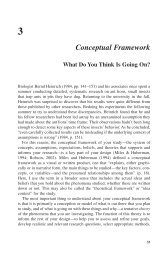Mixed Integer Linear Programming in Process Scheduling: Modeling ...
Mixed Integer Linear Programming in Process Scheduling: Modeling ...
Mixed Integer Linear Programming in Process Scheduling: Modeling ...
You also want an ePaper? Increase the reach of your titles
YUMPU automatically turns print PDFs into web optimized ePapers that Google loves.
142 FLOUDAS AND LIN<br />
simple forms of the objective function, all the nonl<strong>in</strong>earities can be elim<strong>in</strong>ated and large<br />
MILP models are generated.<br />
In addition to the alternative ways to represent variable tim<strong>in</strong>gs and to def<strong>in</strong>e allocation<br />
and sequenc<strong>in</strong>g variables, the various global event based cont<strong>in</strong>uous-time models<br />
may also differ <strong>in</strong> the exact def<strong>in</strong>ition of events, the process representation framework,<br />
and the characteristics of the specific chemical process under <strong>in</strong>vestigation. For example,<br />
Castro, Barbosa-Póvoa, and Matos (2001) proposed an RTN based MILP formulation<br />
for the short-term schedul<strong>in</strong>g of batch processes. Majozi and Zhu (2001) presented an<br />
MILP model for the short-term schedul<strong>in</strong>g of batch processes based on a new process<br />
representation called State Sequence Network. They used time po<strong>in</strong>ts to denote the use<br />
or production of states and <strong>in</strong>troduced b<strong>in</strong>ary variables y(s, p) associated with the usage<br />
of state (s)attime po<strong>in</strong>t (p). Their formulation leads to small MILP problems, but relies<br />
on the def<strong>in</strong>ition of effective states which are related to tasks and units. Lee, Park, and<br />
Lee (2001) reported an STN based MILP formulation for batch and cont<strong>in</strong>uous processes,<br />
which <strong>in</strong>troduced three sets of b<strong>in</strong>ary variables to account for the start, process,<br />
and end events of each task. Burkard, Fortuna, and Hurkens (2002) developed an STN<br />
based MILP formulation for the makespan m<strong>in</strong>imization problem for batch processes<br />
and discussed the choice of the objective function and additional constra<strong>in</strong>ts. Wang and<br />
Guignard (2002) presented an STN based MILP formulation for batch process schedul<strong>in</strong>g<br />
problems, which proposed the def<strong>in</strong>ition of events associated with <strong>in</strong>ventory changes<br />
to reduce the total number of events required to model a schedule. Maravelias and Grossmann<br />
(2003) proposed an STN based MILP model for the short-term schedul<strong>in</strong>g of<br />
multipurpose batch processes which features the elim<strong>in</strong>ation of variables for task start<strong>in</strong>g<br />
times, a set of tighten<strong>in</strong>g <strong>in</strong>equalities to improve the LP relaxation, and accounts for<br />
constra<strong>in</strong>ts on resources other than equipment.<br />
The global event based cont<strong>in</strong>uous-time models can <strong>in</strong>corporate a wide variety of<br />
considerations <strong>in</strong> process schedul<strong>in</strong>g, such as <strong>in</strong>termediate storage, change-over, batch<br />
and cont<strong>in</strong>uous operational modes, due dates, renewable resources, and various objective<br />
functions.<br />
All the global event based cont<strong>in</strong>uous-time models discussed above use an a priori<br />
number of events/time slots/time po<strong>in</strong>ts. As po<strong>in</strong>ted out by Zhang and Sargent (1996),<br />
an important issue is the estimation and adjustment of this number. An underestimation<br />
may lead to suboptimal solutions or even <strong>in</strong>feasible problems, while an overestimation<br />
results <strong>in</strong> unnecessarily large problems, which <strong>in</strong>crease even more the difficulty of the<br />
solution. Despite its significance, relatively little attention has been paid on this issue <strong>in</strong><br />
the literature. Two exceptions are the work presented by Schill<strong>in</strong>g (1997) and recently by<br />
Castro, Barbosa-Póvoa, and Matos (2001). They proposed an iterative procedure <strong>in</strong> which<br />
the model beg<strong>in</strong>s with a small number of events and then the number is gradually <strong>in</strong>creased<br />
until no improvement can be achieved. However, as reported by Castro, Barbosa-Póvoa,<br />
and Matos (2001), <strong>in</strong> some cases, the solution may improve only after the addition of more<br />
than one event, which creates difficulty for the establishment of a stopp<strong>in</strong>g criterion that<br />
can guarantee the optimality of the solution. In a more recent work, Burkard, Fortuna,<br />
and Hurkens (2002) derived lower and upper bounds of the total number of batches
















